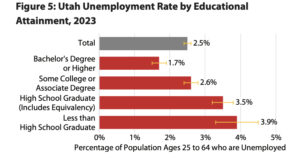Utah’s investment in higher education pays significant dividends, according to a new policy brief from the Kem C. Gardner Policy Institute. The report highlights the state’s exceptionally well-trained workforce, robust economic performance and strong social fabric, all directly linked to a long-standing educational commitment. This emphasis on higher education extends far beyond the economic impacts, contributing to social well-being, civic engagement and innovation.
The report demonstrates the profound and multifaceted impact of Utah’s higher education system, which provides benefits well beyond campus, according to Geoffrey Landward, Utah Commissioner of Higher Education.

Geoffrey Landward
“It is astonishing the impact that higher education has, not only in things like income … but throughout the citizenry and the way of life that we have here in Utah,” he said in a press briefing Thursday. “I’m thrilled to see that when we talk about Utah and its accolades, Utah is often singled out as one of the highest performing states in many measures, economic growth, well-being, happiness, innovation. When I talk to colleagues in other states, the questions are, how is Utah doing it? What is the secret? What are they doing well? And what this report says to me is the secret is a strong, thriving, higher education system.”
The report’s lead author Andrea Brandley, Gardner’s senior education analyst, highlighted the powerful associations between a college degree and positive social, health and economic outcomes, demonstrating how education plays a crucial role in shaping individuals, communities and the state’s future. Increased earnings potential is just part of the story.
“We see significantly better health outcomes when looking across educational attainment for those with more education,” Brandley said. “We see a very similar pattern when looking at health care coverage. Ninety-seven percent of those who are college graduates have health care coverage compared to just under 90% of those with a high school diploma. That drops pretty significantly for those with less than a high school diploma, less than two thirds of them have healthcare coverage.”

Across Utah’s network of 16 public institutions of higher learning, some 240,000 students are enrolled, gaining the skills and knowledge to help them contribute to Utah’s workforce. A policy brief Gardner released last year showed that for every dollar Utah spent on higher education, three are returned in the form of increased tax revenue.
“Higher education benefits the economy,” Brandley said. “This is through workforce development, job and business creation and research and innovation.”
Key findings from the new brief include the following:
Economic Contributions
Utah’s public higher education system supports approximately 132,000 jobs and contributes $12.1 billion to the state’s GDP. Research universities are especially vital drivers of economic growth, providing 83% of the system’s total economic contribution.
Earnings and Economic Stability
Individuals with higher educational attainment enjoy significantly higher incomes, economic stability, and improved life quality, with median earnings rising steadily with each level of education. Unemployment and poverty rates are substantially lower among those with college degrees. For example, the 2023 unemployment rate of Utahns with a bachelor’s degree or higher tallies 1.8 percentage points lower than those with a high school diploma alone.
Reduced Disparities and Increased Mobility
Higher education helps reduce economic inequalities and fosters upward mobility. Students with family members holding postgraduate degrees are more likely to complete their postsecondary education. Nationally, 74% of people with a college degree achieve a family income higher than their parents.
Health Outcomes
Utahns with higher education levels report better health outcomes, including higher rates of excellent/very good health and greater health care coverage. Approximately 92% of Utah adults with a college degree reported good, very good or excellent general health in 2023.
Civic Engagement
Higher education fosters greater civic engagement, including significantly higher rates of volunteerism and voter participation. In 2023, 78% of Utahns with a certificate, associate degree, bachelor’s degree, or post-graduate degree reported always or often voting in state elections compared to 53% of those who discontinued high school, earned a high school degree/GED or attended some college.
Reliance on Public Assistance
Data show a significant reduction in the use of public assistance among individuals with postsecondary degrees. For example, 30% of adults ages 25 or older in the U.S. receive Medicaid, compared to 11% among those with a bachelor’s degree or higher.
Skilled Workforce
Utah’s higher education system consistently produces a skilled workforce, with many graduates receiving high-yield degrees matching in-demand jobs within the state. Approximately 72% of degrees awarded by the Utah System of Higher Education in 2024 were classified as “high yield” degrees, meaning they feature training for high-wage/high-demand jobs.
Innovation and Economic Multiplier
Utah benefits from a strong innovation ecosystem fostered by its research universities. Higher education in Utah also possesses a significant economic multiplier, magnifying its positive impact on the state’s economy. Utah’s level of innovation ranked highest in the nation, according to a recent study by the Indiana Business Research Center.
The full policy brief is available online.
MEDIA & PR CONTACTS
-
Nick Thiriot
Kem C. Gardner Policy Institute communications director
801-842-9150 nick.thiriot@utah.edu
